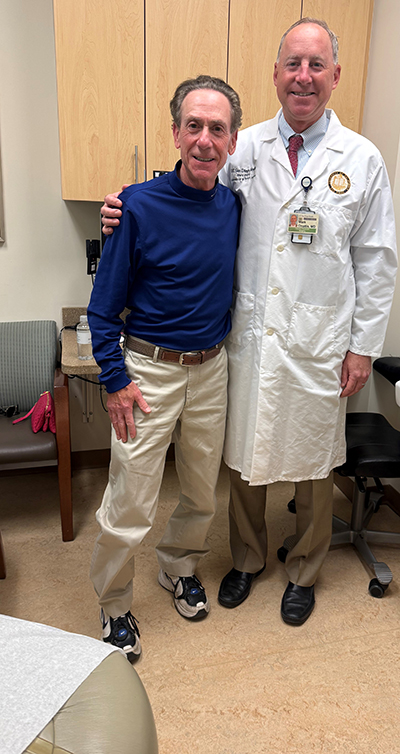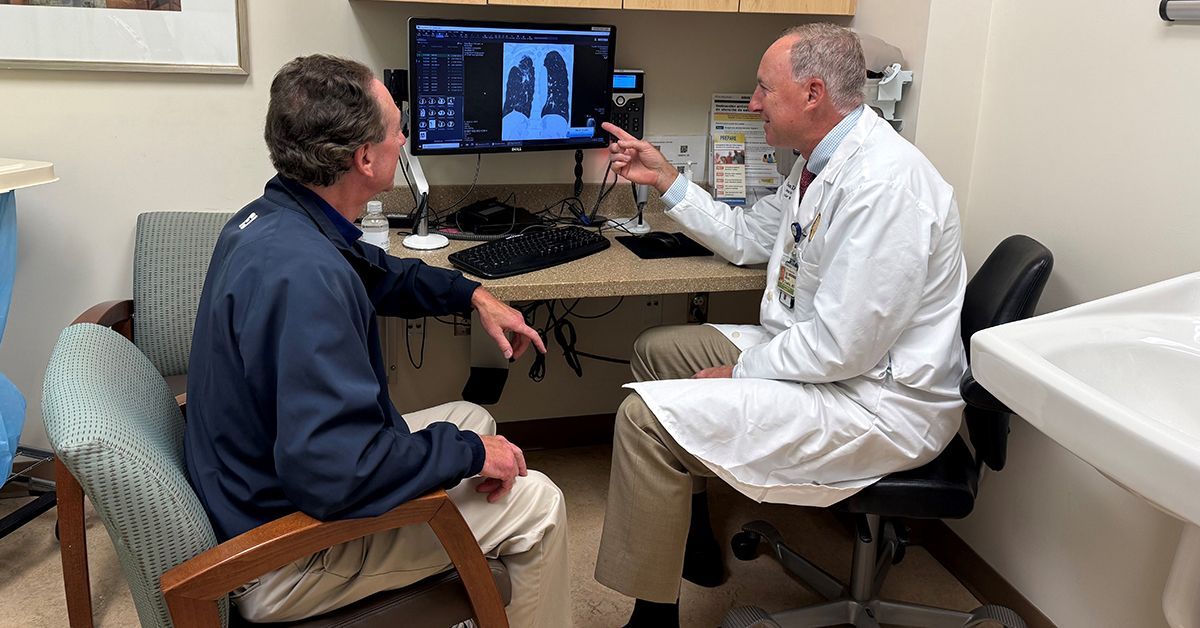Patient Shares Gratitude for Life-Saving Lung Cancer Treatment
A leader in the region for pulmonary care, UC San Diego Health uses a multidisciplinary, comprehensive approach for lung cancer detection, diagnosis and treatment
Story by:
Published Date
Article Content
David Katz was driving home from Las Vegas when he abruptly began to feel dizzy, couldn’t see clearly and began to swerve in and out of the freeway lanes. Out of concerns he might be having a stroke, Katz’s wife directed him from the passenger seat to pull the car over so they could call their physician’s office.
“We were told to get to the hospital right away,” remembered Katz. “My wife drove us straight to Jacobs Medical Center while I rested, drank water and tried to eat in the car.”
Three hours later, the couple arrived at the UC San Diego Health hospital in La Jolla where an emergency medical team was waiting at the ready after initiating a code stroke response team. There, Katz underwent an MRI and head CT scan to determine the cause of his symptoms and to confirm if he was experiencing a stroke.
“Thankfully, I did not have a stroke,” said Katz. “I was diagnosed with potential dehydration.”
But after getting home, the unexpected happened.

“I was feeling so relieved and thankful for our health when the phone rings,” said Katz. “It was the emergency department doctor who shared that while the results of my CT scan confirmed I did not have a stroke, it also identified a suspicious spot on the upper lobe of my right lung.”
As a result of the incidental finding from the head CT performed in the Emergency Department, Katz was referred to George Cheng, MD, interventional pulmonologist at UC San Diego Health, for a chest CT scan and subsequent biopsy of the nodule, or lump, found in his right lung.
Unfortunately, Katz’s biopsy confirmed what he and his wife had feared: lung cancer.
“We received a call from Dr. Cheng and he told us the news. I was diagnosed with an early staged lung cancer, known as adenocarcinoma,” said Katz. “We couldn’t believe it. I had no symptoms, I haven’t smoked in more than 40 years, I eat right and I exercise. Needless to say, we were shocked.”
Katz considered himself very lucky, however, because his cancer was caught early.
“Had I not gotten that initial head CT in the emergency room, I would not have known of the cancer growing inside my lung,” added Katz.
Every two minutes, someone in the U.S. is diagnosed with lung cancer
According to the American Lung Association, an adult in the United States is diagnosed with lung cancer every two minutes, and approximately 10% of those diagnoses are among individuals who have never smoked.
Lung cancer is the leading cause of cancer death in the United States and across the world. In the U.S. alone, it is responsible for more deaths than breast, colorectal, ovarian and prostate cancers combined. In 2024, it’s expected there will be more than 200,000 new diagnoses of lung cancer, with non-smoking lung cancer the fifth most common.
Typically, lung cancer does not cause any symptoms until it has spread. The most common symptoms include a cough that does not go away or gets worse, coughing up blood, chest pain that is worse with deep breaths, new onset of wheezing and shortness of breath. If lung cancer has spread to other parts of the body, symptoms may include bone pain in the back or hips and swelling of the lymph nodes.
When found early, lung cancer is more likely to be treated successfully. However, only a quarter of cases diagnosed each year are at an early stage and rates for lung cancer screening are extremely low across the country.
“Early diagnosis of lung cancer can greatly improve patient outcomes as we can begin treatment much sooner,” said Cheng. “This is why comprehensive lung cancer detection programs that include both lung cancer screening and incidental lung nodule programs are paramount.”
The Lung Cancer Screening Program at UC San Diego Health is available to patients who fit certain criteria considered high-risk for developing lung cancer. For those who are experiencing symptoms, individuals should speak with their primary care provider for potential testing.
The cancer screening is based on the results of a CT scan that limits radiation exposure to the lungs. The scan produces detailed, cross-sectional image of the lungs, which a radiologist then examines for signs of disease.
At UC San Diego Health, a system-wide effort for incidental lung nodule detection has recently been implemented. According to Cheng, this complementary program attempts to catch any suspicious nodules found in patients who do not meet lung cancer screening criteria and serves as a “safety net” for patients.

“The radiologist in the emergency room went above and beyond. He looked beyond the signs of a stroke in my initial CT scan and found the spot on my lung,” said Katz. “It’s because of him that my cancer was found early.”
UC San Diego Health is on the forefront of treatment options
Treatment for lung cancer depends on the size and location of the nodule. If the nodule is easily accessible, the patient will undergo a biopsy to test for cancer, which will determine if additional medical care, such as surgery, chemotherapy, radiation therapy or immunotherapy is required.
For patients like Katz, robotic-assisted bronchoscopy may be recommended for biopsy when the lung nodule is very small or located in an area that is difficult to access.
“Bronchoscopy is a procedure we use to see into a person’s lungs using a bronchoscope, or thin, lighted tube with a camera at the end,” said Cheng, who is also a UC San Diego Moores Cancer Center member. “During a robotic-assisted bronchoscopy, we use a robotic system to precisely guide a small, flexible tube with a camera to reach areas of the lung that would otherwise be difficult or impossible to access. We collect samples for diagnose of various lung conditions, such as cancer, with better accuracy and safety.”
During the procedure, a 3-D map of the lung can be viewed on a computer screen that allows the provider to locate the mass and obtain a sample.
“With advancing technology, the field of interventional pulmonology is continually evolving and UC San Diego Health is on the forefront,” said Cheng.
Top 10 in the nation for pulmonology care, according to U.S. News & World Report 2024-2025 rankings, UC San Diego Health began offering robotic bronchoscopy in 2021 and has since completed 1,000 cases. Before this technology, patients often had to wait for another CT scan to see if a suspicious lung nodule had grown or potentially undergo an invasive procedure in order to get a diagnosis.
As the only National Cancer Institute-designated Comprehensive Cancer Center in San Diego, our cancer care teams rely on a multidisciplinary approach to care, with experts ranging from nursing, interventional pulmonology, interventional radiology, medical oncology, radiation oncology, CT surgery and thoracic surgery. As part of our NCI-designation and as an academic medical center, UC San Diego Health also provides new, advanced treatments soon after clinical trial completion that are not available elsewhere.
After undergoing a biopsy, Katz was referred to Mark Onaitis, MD, thoracic surgeon at UC San Diego Health, to remove the cancerous tumor from his lung.
“When cancer has not spread beyond the lungs, surgery is typically seen as a curative treatment for patients with early stage lung cancer,” said Onaitis, who is also a UC San Diego Moores Cancer Center member. “Mr. Katz underwent a robotic, complete resection of his upper right lobe — including lymph nodes within and around the lobe and in the chest — to ensure we removed all the cancerous cells from his affected lung and to make sure that there were no lymph node metastases. Overall, he did really well.”
For specific qualifying patients, Cheng and Onaitis are also able to offer biopsy, diagnosis and tumor resection all in one surgery event. This approach, which is the only of its kind in the region, shortens the time from diagnosis to therapy and allows patients to be treated for their lung cancer much quicker.
“In our clinic, we have specialists with expertise in interventional pulmonology, surgery, immunotherapy, chemotherapy and radiation therapy,” said Onaitis. “Through this exceptional team effort, we can alleviate some anxiety of a lung cancer diagnosis because we provide our patients with their specific treatment plan on their very first appointment.”
Now two years cancer free, Katz is back to focusing on his golf swing and enjoying retirement with his family.
“When you receive a cancer diagnosis, it’s devastating. I wanted to know how it happened so I could change whatever I was doing that gave me cancer,” said Katz. “However, I realized there was nothing I could have possibly done to prevent this from happening. So instead, I focused on what was in my control, which was my treatment and recovery, all of which I could not have done without my incredible wife and my amazing team at UC San Diego Health.”
“Through this exceptional team effort, we can alleviate some anxiety of a lung cancer diagnosis because we provide our patients with their specific treatment plan on their very first appointment.”
You May Also Like
Stay in the Know
Keep up with all the latest from UC San Diego. Subscribe to the newsletter today.




